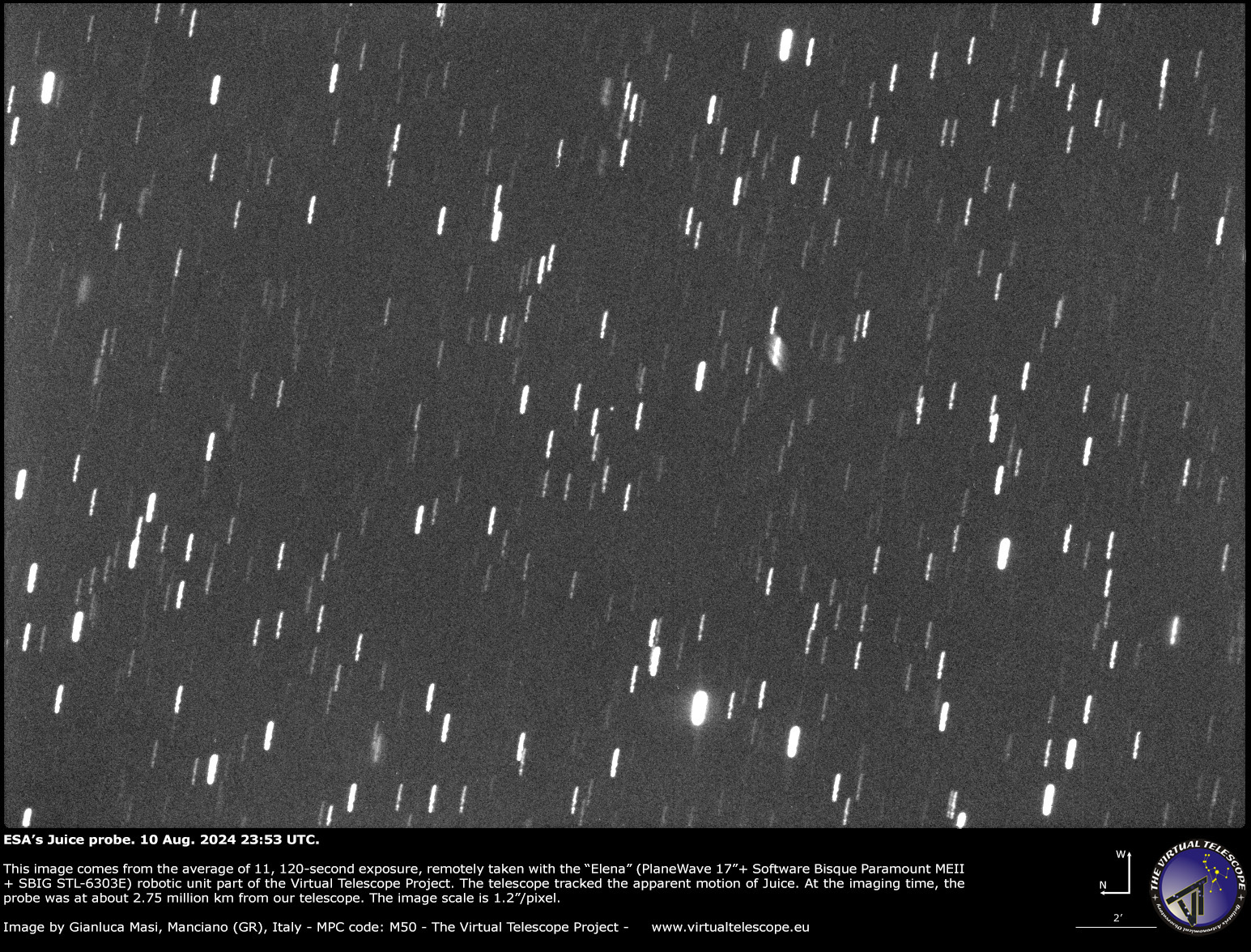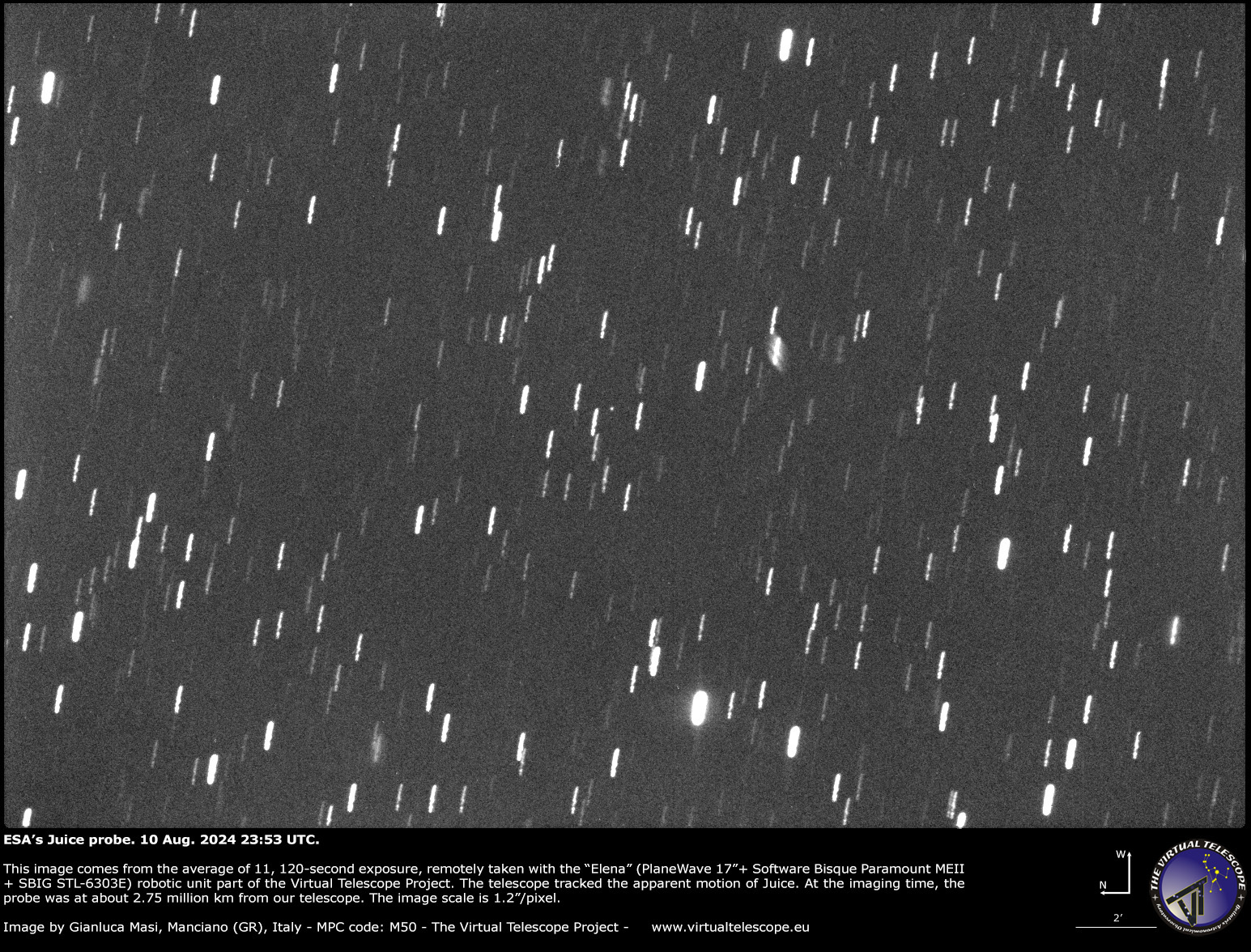For avid skywatchers around the world, this week begins with trying to get a glimpse of the Jupiter-bound JUICE spacecraft that’s set to swing past both the moon and Earth over the span of just one day — a combination scientists have deemed to be the world’s first.
The European Space Agency (ESA) launched JUICE in April last year to explore Jupiter and three of its biggest moons — Ganymede, Callisto and Europa, all of which are thought to contain oceans of liquid water beneath their icy shells. The spacecraft’s two flybys this week, coming close to a year and a half after its launch, are meant to give it a gravitational boost to power its 8-year journey to the gas giant.
A week ago, astrophysicist Gianluca Masi of the Virtual Telescope Project created a timelapse of JUICE’s movement from his view over Italy, capturing the probe as it hurtled toward our moon. At the center of a snapshot (below), JUICE is a faint speck of light among a sea of bright starry trails, seen as it was roughly 1.7 million miles (2.75 million kilometers) from our planet.

JUICE was fainter still in a picture captured by Masi just a day prior, on Aug. 9, when it was roughly 2 million miles (3.3 million kilometers) from Earth.

ESA’s telescopes at the agency’s Optical Ground Station in Tenerife, Spain also captured views of the probe earlier in the month on Aug. 3 and 4.

JUICE will fly past the moon today (Aug. 19) at 5:15 p.m. Eastern time (2115 GMT). At its closest, the spacecraft will be just 460 miles (750 kilometers) above the moon’s surface, and will be capturing two images every minute using onboard cameras originally designed to watch the deployment of its solar panels, ESA said in a statement released today.
Agency officials expect to share the images on social media just minutes after receiving it from the probe, and you can watch them live here on Space.com, courtesy of the ESA.
“We don’t know how the images will look — it’s the first time the cameras will point at a big bright object in space,” ESA said. “We’re sharing them publicly before we’ve had a chance to process them at all — let’s see what happens!”
An animation by amateur astronomer Tony Dunn shows what the flybys would look like — for JUICE, as the probe swings past both the moon and Earth in the span of 24 hours.
The fun starts tomorrow morning. On its way to Jupiter, The Juice spacecraft flies by the Moon for a gravitational assist that will line it up for an Earth gravitational assist a day later. #JUICE @ESA_JUICE pic.twitter.com/NxCGTGveb8August 19, 2024
JUICE’s lunar flyby will be followed by a swing past Earth tomorrow (Aug. 20). It will make a close pass of 4,280 miles (6,900 kilometers) above our planet’s surface, scheduled at 5:57 p.m. Eastern time (2157 GMT). The close approach, which will occur over Southeast Asia and the Pacific Ocean, will bring the spacecraft close enough to Earth that automated warning systems flagged it as a dangerous asteroid.
There is, of course, no risk of JUICE striking Earth. The maneuvers this week are meant to alter the probe’s speed and direction, setting it up for one flyby of Venus next year and two more of Earth by early 2029, all of which will put it on track to arrive in the Jupiter system in 2031 as planned.
The trio of flybys is “the space exploration equivalent of drinking three back-to-back espressos,” ESA officials have previously said.



